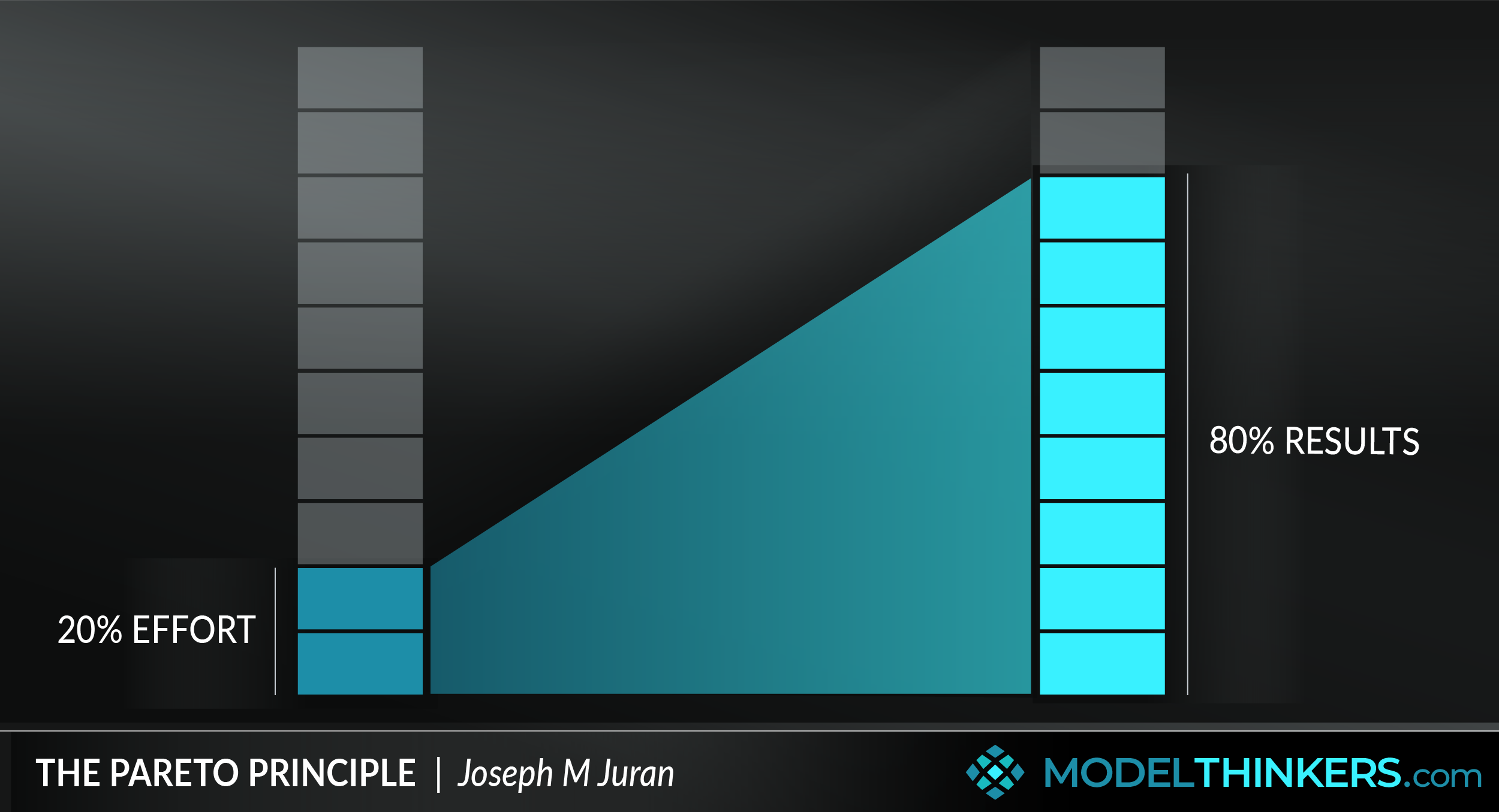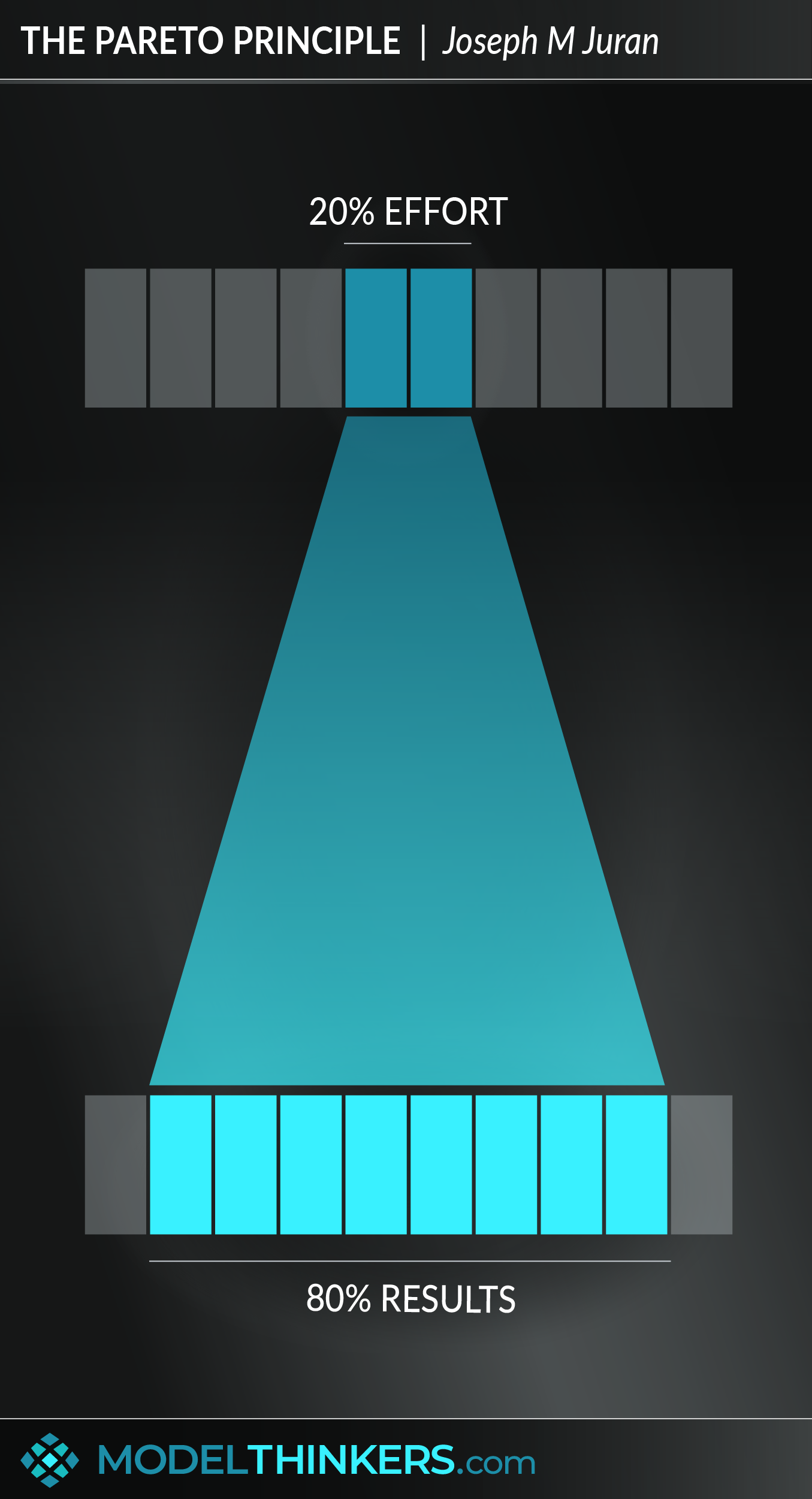

 0 saved
0 saved
 35.2K views
35.2K views








Kill perfectionism, get more done, increase your return on investment and so much more, with this simple and incredibly powerful mental model.
The Pareto Principle suggests about 20% of your activities will account for about 80% of your results.
FINDING THE 20 THAT DELIVERS THE 80.
Also known as the 80:20 Rule or 80:20 Principle, The Pareto Principle would predict that:
- 20% of your clients account for 80% of your income
- 20% of the bugs in your new app account for 80% of the crashes
- 20% of your pitch will make 80% of the impact on your audience
- 20% of your products will generate 80% of your profit
NOT ABOUT THE NUMBERS.
The numbers won't pan out exactly and serve more as a guide than a mathematical rule. Instead, use this model to identify:
- The vital few, or the small number of causal factors that account for the bulk of a problem or situation
- The useful many, the large number of remaining factors that collectively contribute a small amount of the problem or situation
In that context, the real power of the Pareto Principle is to identify the tipping point where you receive Diminishing Returns from your efforts. This will happen in any project, it's that moment where putting more time in simply won't return as high yield as turning your attention elsewhere.
TIME IS FINITE, SO MAKE A CHOICE!
David Allen, the creator of Getting Things Done, famously observed: "You can do anything, but not everything." In that context, the Pareto Principle is a wake-up call to make hard choices about how to spend your finite time and energy.
Observing the Inverse of the Pareto Principle also becomes a warning of the Law of Diminishing Returns. This law identifies that you will reach a point on a project or task where the same energy will deliver diminishing results. In that sense, the Pareto Principle is a guide to strategically stop and say 'no', as you continue to focus on high value activities and investments.
IN YOUR LATTICEWORK.
The Pareto Principle is a powerful prioritisation tool and possibly one of the most versatile models you'll find. Plus it combines well with many other models, so is an important addition to your Latticework. In fact, if you were to apply The Pareto Principle to Munger's Latticework of Models, this would be a model to make the '20' that delivers the '80' of your impact. Yes, I know, that was getting pretty meta, but the point is this model is important.
As noted, it really is the inverse of The Law of Diminishing Returns. You could combine The Pareto Principle with Parkinson's Law, as you identify high-value actions to Timebox; it's behind much of the advice captured in Patil's Project Principles; use it to prioritise as you communicate to high-level stakeholders using Minto's Pyramid; combine its understanding of imbalance with Probabilistic Thinking to gain a stronger understanding of complex situations.
The list could keep going because there are countless opportunities to apply and combine this model — adopt it and quickly see how it becomes one of your most-used models.




- Prioritise high-value areas.
In a world of scarcity, overwhelm and opportunity cost, learn to habitually use the Pareto Principle to identify highest value activity by asking 'what's the 20% in this situation that will deliver most of my results?' Doing so will support you to be more efficient, effective and minimise waste.
- Let go of perfection.
Be aware that prioritising high-value activities to achieve 'enough' impact might mean not addressing areas of lower value. As Jason Fried, author of Rework said: “Find a judo solution, one that delivers maximum efficiency with minimum effort. When good enough gets the job done, go for it.”
- Ask simple questions.
Before you jump into action, apply the Pareto Principle by asking yourself questions such as:
- "Is this the most important thing I could do right now?"
- "Could someone else do this?"
- "What's my Opportunity Cost of doing this?"
- "What's the most impactful thing I can do?"
- Use the Pareto table
For a more structured approach, you might look at how the originator of the Pareto Principle used it. In the context of quality management, Joseph M Juran used a 'Pareto table' which consisted of 4 columns to identify error frequency in a project. The first column identified the item or contributors, the second the number of errors, the third the % of the total with the fourth the cumulative % of the total. This provides data to quickly establish what is contributing to the '80% of results.
There is a risk in strictly adhering to the numbers in the Pareto Principle when the real power of this model lies in the principle of identifying 'the vital few' and the 'useful many'.
Another potential limitation lies in challenges with complex causal factors and dependencies. For example, a client in the '80', who does not directly lead to the bulk of sales, might still be an influencer who impacts on purchases from several clients in the '20'. Likewise, a bug that does not contribute to the 80% of errors, still might be the basis of a rare but critical error.
Charles Munger on mental models.
Charles Munger advocates for developing a ‘latticework of mental models’ which underlies Model Thinkers. In terms of which models to select, Munger points out: “But, fortunately, it isn’t that tough—because 80 or 90 important models will carry about 90% of the freight in making you a worldly-wise person. And, of those, only a mere handful really carry very heavy freight.”
Pareto’s pea pods example.
According to legends, Pareto noticed that 20% of the pea pods in his garden delivered 80% of the peas. He later established that 20% of the population in Italy owned 80% of the land.
The Pareto principle is one of the most versatile models you’ll find, it can be used in many domains and in combination with countless mental models to help identify value and prioritise effort.
Use the following examples of connected and complementary models to weave the Pareto principle into your broader latticework of mental models. Alternatively, find your own connections by exploring the category list above.
Connected models:
- Bottleneck: finding the point of limitation is a different but related method to prioritise activity and investment.
- Eisenhower matrix: a practical task based approach to maintaining high value activity.
- Leverage: finding the point of highest impact.
- Catalyst and activation energy: relating to identifying and capitalising on change opportunities.
- Leverage: and identifying the point to apply force.
- Buffet’s 2 lists: another mental model to prioritise and focus.
Complementary models:
- Munger’s latticework: use the Pareto principle when selecting mental models to include in your latticework.
- Compounding: use the Pareto principle to achieve high value marginal gains in combination with compounding.
- Inversion: help to identify key challenges and risks and see problems differently by combining with inversion.
- Cost-benefit analysis: rather than simply weighing costs and benefits, combine with the Pareto principle to provide weighted and prioritised impact for each element.
The Pareto Principle was popularised by Management and Quality Consultant Joseph M Juran, who was inspired by the research of economist Vifredo Pareto and named it after him as a result. Juran's organisation continues to use the mental model in their consulting work, as you can see here.
You can also view Richard Kock's book exploring the principle here.
 My Notes
My Notes
Oops, That’s Members’ Only!
Fortunately, it only costs US$5/month to Join ModelThinkers and access everything so that you can rapidly discover, learn, and apply the world’s most powerful ideas.
ModelThinkers membership at a glance:






“Yeah, we hate pop ups too. But we wanted to let you know that, with ModelThinkers, we’re making it easier for you to adapt, innovate and create value. We hope you’ll join us and the growing community of ModelThinkers today.”






















































































